Cyber Security in Maritime Industries: Threats and Countermeasures
VerifiedAdded on 2021/06/14
|15
|4207
|35
Report
AI Summary
This report delves into the critical issue of cyber security within the maritime industry, highlighting its significance in the face of increasing technological advancements and global trade reliance on shipping. It uses the Cyprus Shipping Chamber as a case study, examining its IT environment, including cyber security resilience management, assessment procedures, and penetration testing. The report outlines the risks and threats, such as network vulnerabilities, malware, and human error, while proposing countermeasures like network security, malware protection, and crew training. The report emphasizes the need for proactive measures to mitigate cyber risks, including implementing SEIM, utilizing third-party monitoring, and defining clear responsibilities for cyber risk management. It underscores the evolving nature of cyber threats and the importance of continuous investment in cyber security education and training to safeguard the maritime industry's operations and assets.
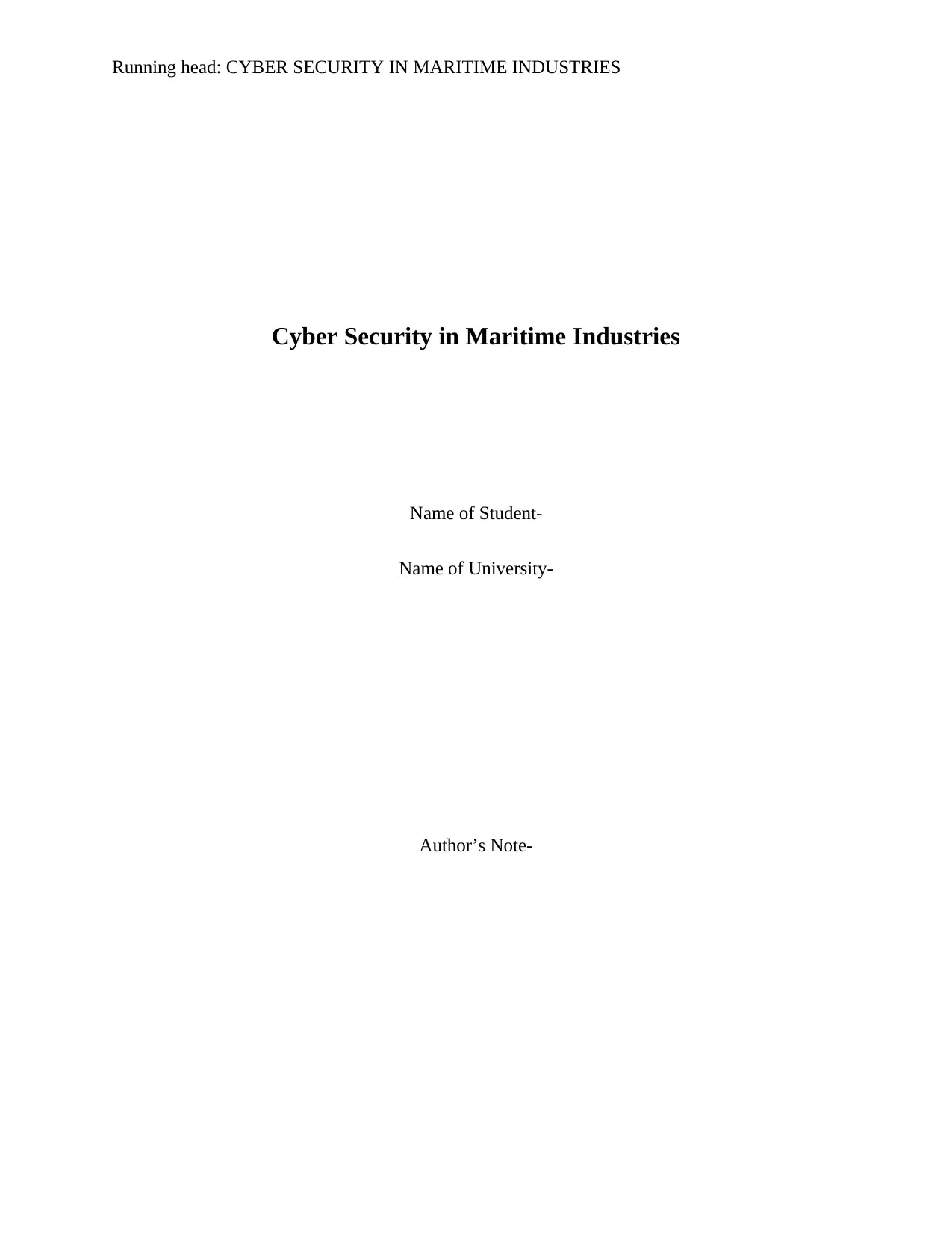
Running head: CYBER SECURITY IN MARITIME INDUSTRIES
Cyber Security in Maritime Industries
Name of Student-
Name of University-
Author’s Note-
Cyber Security in Maritime Industries
Name of Student-
Name of University-
Author’s Note-
Paraphrase This Document
Need a fresh take? Get an instant paraphrase of this document with our AI Paraphraser
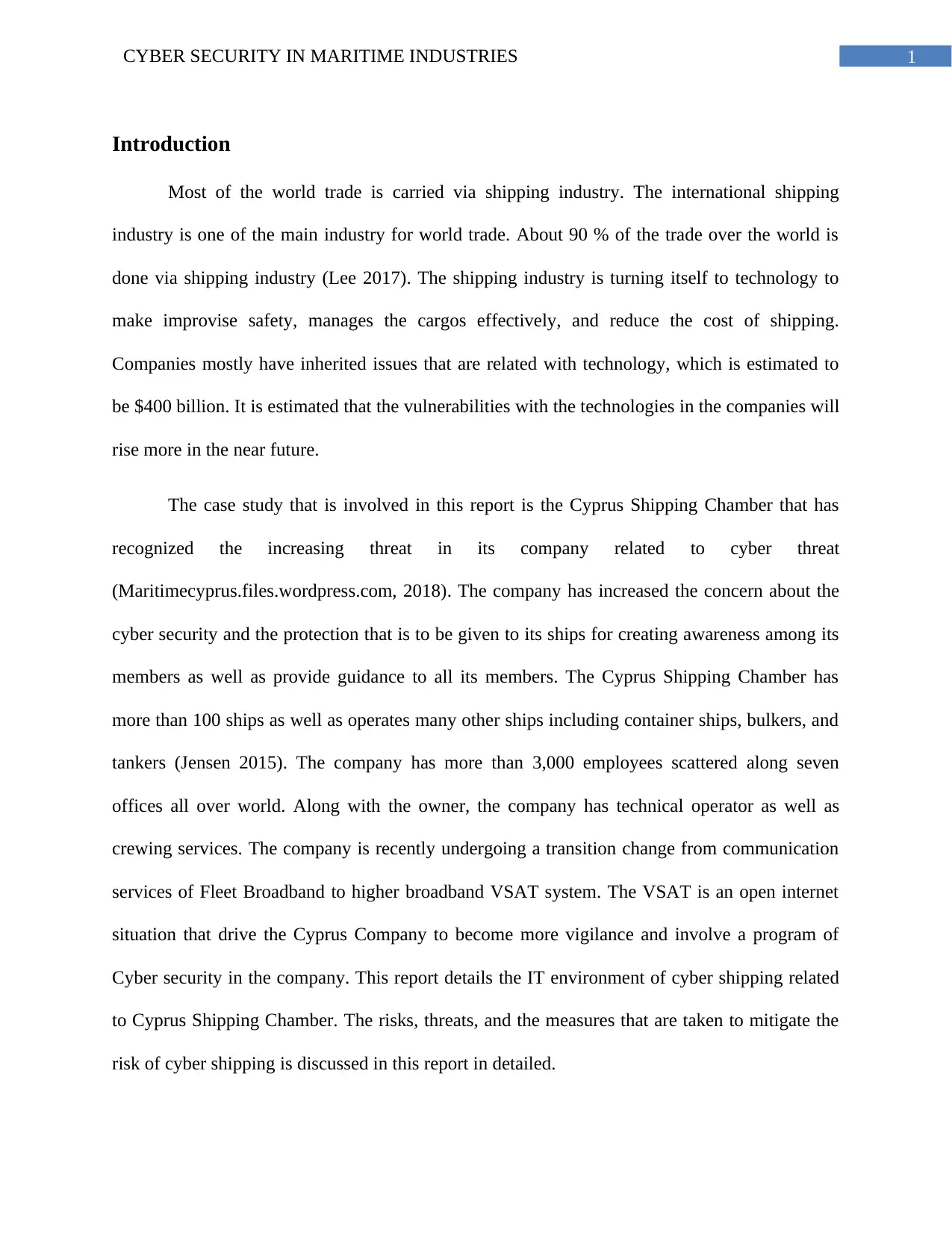
1CYBER SECURITY IN MARITIME INDUSTRIES
Introduction
Most of the world trade is carried via shipping industry. The international shipping
industry is one of the main industry for world trade. About 90 % of the trade over the world is
done via shipping industry (Lee 2017). The shipping industry is turning itself to technology to
make improvise safety, manages the cargos effectively, and reduce the cost of shipping.
Companies mostly have inherited issues that are related with technology, which is estimated to
be $400 billion. It is estimated that the vulnerabilities with the technologies in the companies will
rise more in the near future.
The case study that is involved in this report is the Cyprus Shipping Chamber that has
recognized the increasing threat in its company related to cyber threat
(Maritimecyprus.files.wordpress.com, 2018). The company has increased the concern about the
cyber security and the protection that is to be given to its ships for creating awareness among its
members as well as provide guidance to all its members. The Cyprus Shipping Chamber has
more than 100 ships as well as operates many other ships including container ships, bulkers, and
tankers (Jensen 2015). The company has more than 3,000 employees scattered along seven
offices all over world. Along with the owner, the company has technical operator as well as
crewing services. The company is recently undergoing a transition change from communication
services of Fleet Broadband to higher broadband VSAT system. The VSAT is an open internet
situation that drive the Cyprus Company to become more vigilance and involve a program of
Cyber security in the company. This report details the IT environment of cyber shipping related
to Cyprus Shipping Chamber. The risks, threats, and the measures that are taken to mitigate the
risk of cyber shipping is discussed in this report in detailed.
Introduction
Most of the world trade is carried via shipping industry. The international shipping
industry is one of the main industry for world trade. About 90 % of the trade over the world is
done via shipping industry (Lee 2017). The shipping industry is turning itself to technology to
make improvise safety, manages the cargos effectively, and reduce the cost of shipping.
Companies mostly have inherited issues that are related with technology, which is estimated to
be $400 billion. It is estimated that the vulnerabilities with the technologies in the companies will
rise more in the near future.
The case study that is involved in this report is the Cyprus Shipping Chamber that has
recognized the increasing threat in its company related to cyber threat
(Maritimecyprus.files.wordpress.com, 2018). The company has increased the concern about the
cyber security and the protection that is to be given to its ships for creating awareness among its
members as well as provide guidance to all its members. The Cyprus Shipping Chamber has
more than 100 ships as well as operates many other ships including container ships, bulkers, and
tankers (Jensen 2015). The company has more than 3,000 employees scattered along seven
offices all over world. Along with the owner, the company has technical operator as well as
crewing services. The company is recently undergoing a transition change from communication
services of Fleet Broadband to higher broadband VSAT system. The VSAT is an open internet
situation that drive the Cyprus Company to become more vigilance and involve a program of
Cyber security in the company. This report details the IT environment of cyber shipping related
to Cyprus Shipping Chamber. The risks, threats, and the measures that are taken to mitigate the
risk of cyber shipping is discussed in this report in detailed.
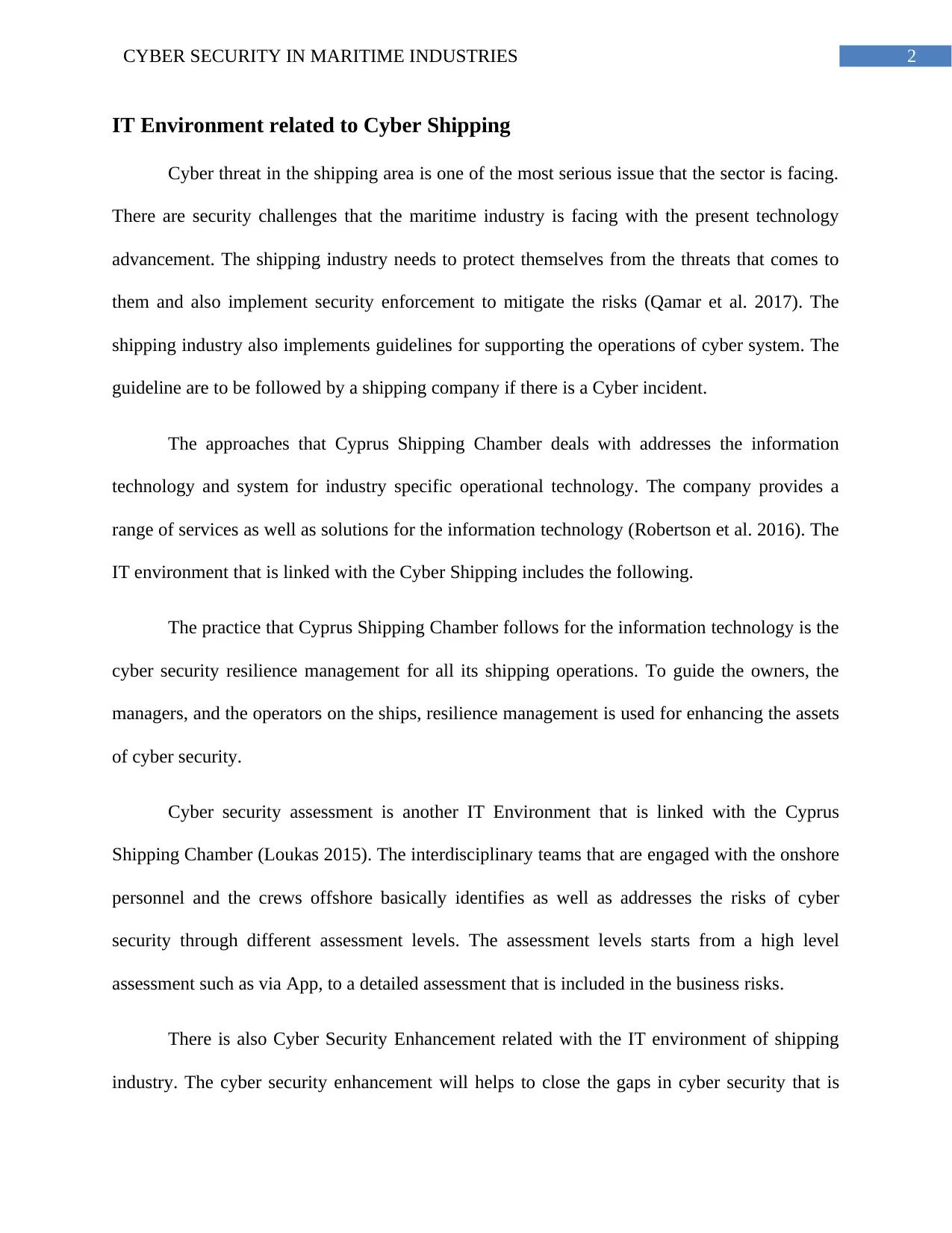
2CYBER SECURITY IN MARITIME INDUSTRIES
IT Environment related to Cyber Shipping
Cyber threat in the shipping area is one of the most serious issue that the sector is facing.
There are security challenges that the maritime industry is facing with the present technology
advancement. The shipping industry needs to protect themselves from the threats that comes to
them and also implement security enforcement to mitigate the risks (Qamar et al. 2017). The
shipping industry also implements guidelines for supporting the operations of cyber system. The
guideline are to be followed by a shipping company if there is a Cyber incident.
The approaches that Cyprus Shipping Chamber deals with addresses the information
technology and system for industry specific operational technology. The company provides a
range of services as well as solutions for the information technology (Robertson et al. 2016). The
IT environment that is linked with the Cyber Shipping includes the following.
The practice that Cyprus Shipping Chamber follows for the information technology is the
cyber security resilience management for all its shipping operations. To guide the owners, the
managers, and the operators on the ships, resilience management is used for enhancing the assets
of cyber security.
Cyber security assessment is another IT Environment that is linked with the Cyprus
Shipping Chamber (Loukas 2015). The interdisciplinary teams that are engaged with the onshore
personnel and the crews offshore basically identifies as well as addresses the risks of cyber
security through different assessment levels. The assessment levels starts from a high level
assessment such as via App, to a detailed assessment that is included in the business risks.
There is also Cyber Security Enhancement related with the IT environment of shipping
industry. The cyber security enhancement will helps to close the gaps in cyber security that is
IT Environment related to Cyber Shipping
Cyber threat in the shipping area is one of the most serious issue that the sector is facing.
There are security challenges that the maritime industry is facing with the present technology
advancement. The shipping industry needs to protect themselves from the threats that comes to
them and also implement security enforcement to mitigate the risks (Qamar et al. 2017). The
shipping industry also implements guidelines for supporting the operations of cyber system. The
guideline are to be followed by a shipping company if there is a Cyber incident.
The approaches that Cyprus Shipping Chamber deals with addresses the information
technology and system for industry specific operational technology. The company provides a
range of services as well as solutions for the information technology (Robertson et al. 2016). The
IT environment that is linked with the Cyber Shipping includes the following.
The practice that Cyprus Shipping Chamber follows for the information technology is the
cyber security resilience management for all its shipping operations. To guide the owners, the
managers, and the operators on the ships, resilience management is used for enhancing the assets
of cyber security.
Cyber security assessment is another IT Environment that is linked with the Cyprus
Shipping Chamber (Loukas 2015). The interdisciplinary teams that are engaged with the onshore
personnel and the crews offshore basically identifies as well as addresses the risks of cyber
security through different assessment levels. The assessment levels starts from a high level
assessment such as via App, to a detailed assessment that is included in the business risks.
There is also Cyber Security Enhancement related with the IT environment of shipping
industry. The cyber security enhancement will helps to close the gaps in cyber security that is
⊘ This is a preview!⊘
Do you want full access?
Subscribe today to unlock all pages.

Trusted by 1+ million students worldwide
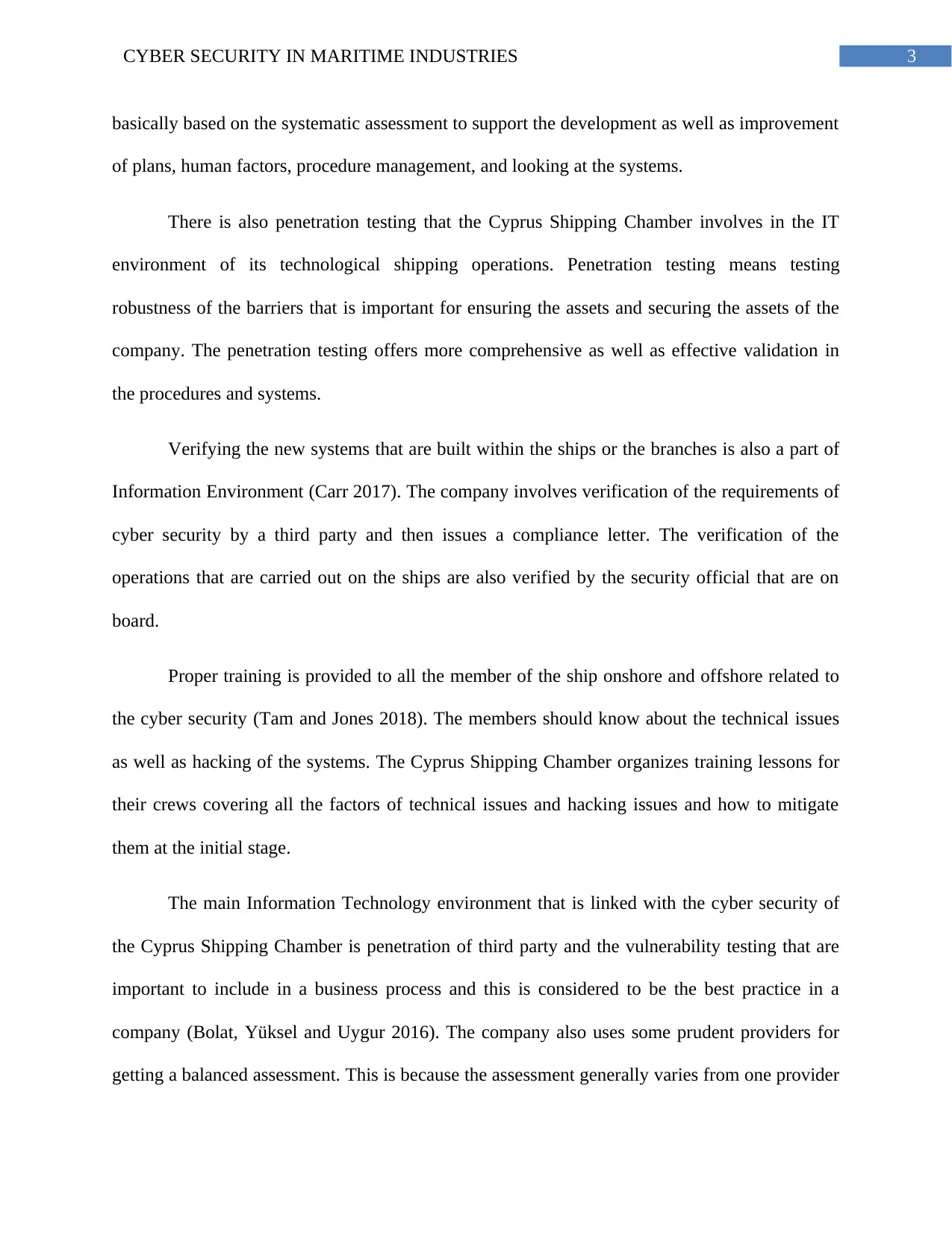
3CYBER SECURITY IN MARITIME INDUSTRIES
basically based on the systematic assessment to support the development as well as improvement
of plans, human factors, procedure management, and looking at the systems.
There is also penetration testing that the Cyprus Shipping Chamber involves in the IT
environment of its technological shipping operations. Penetration testing means testing
robustness of the barriers that is important for ensuring the assets and securing the assets of the
company. The penetration testing offers more comprehensive as well as effective validation in
the procedures and systems.
Verifying the new systems that are built within the ships or the branches is also a part of
Information Environment (Carr 2017). The company involves verification of the requirements of
cyber security by a third party and then issues a compliance letter. The verification of the
operations that are carried out on the ships are also verified by the security official that are on
board.
Proper training is provided to all the member of the ship onshore and offshore related to
the cyber security (Tam and Jones 2018). The members should know about the technical issues
as well as hacking of the systems. The Cyprus Shipping Chamber organizes training lessons for
their crews covering all the factors of technical issues and hacking issues and how to mitigate
them at the initial stage.
The main Information Technology environment that is linked with the cyber security of
the Cyprus Shipping Chamber is penetration of third party and the vulnerability testing that are
important to include in a business process and this is considered to be the best practice in a
company (Bolat, Yüksel and Uygur 2016). The company also uses some prudent providers for
getting a balanced assessment. This is because the assessment generally varies from one provider
basically based on the systematic assessment to support the development as well as improvement
of plans, human factors, procedure management, and looking at the systems.
There is also penetration testing that the Cyprus Shipping Chamber involves in the IT
environment of its technological shipping operations. Penetration testing means testing
robustness of the barriers that is important for ensuring the assets and securing the assets of the
company. The penetration testing offers more comprehensive as well as effective validation in
the procedures and systems.
Verifying the new systems that are built within the ships or the branches is also a part of
Information Environment (Carr 2017). The company involves verification of the requirements of
cyber security by a third party and then issues a compliance letter. The verification of the
operations that are carried out on the ships are also verified by the security official that are on
board.
Proper training is provided to all the member of the ship onshore and offshore related to
the cyber security (Tam and Jones 2018). The members should know about the technical issues
as well as hacking of the systems. The Cyprus Shipping Chamber organizes training lessons for
their crews covering all the factors of technical issues and hacking issues and how to mitigate
them at the initial stage.
The main Information Technology environment that is linked with the cyber security of
the Cyprus Shipping Chamber is penetration of third party and the vulnerability testing that are
important to include in a business process and this is considered to be the best practice in a
company (Bolat, Yüksel and Uygur 2016). The company also uses some prudent providers for
getting a balanced assessment. This is because the assessment generally varies from one provider
Paraphrase This Document
Need a fresh take? Get an instant paraphrase of this document with our AI Paraphraser
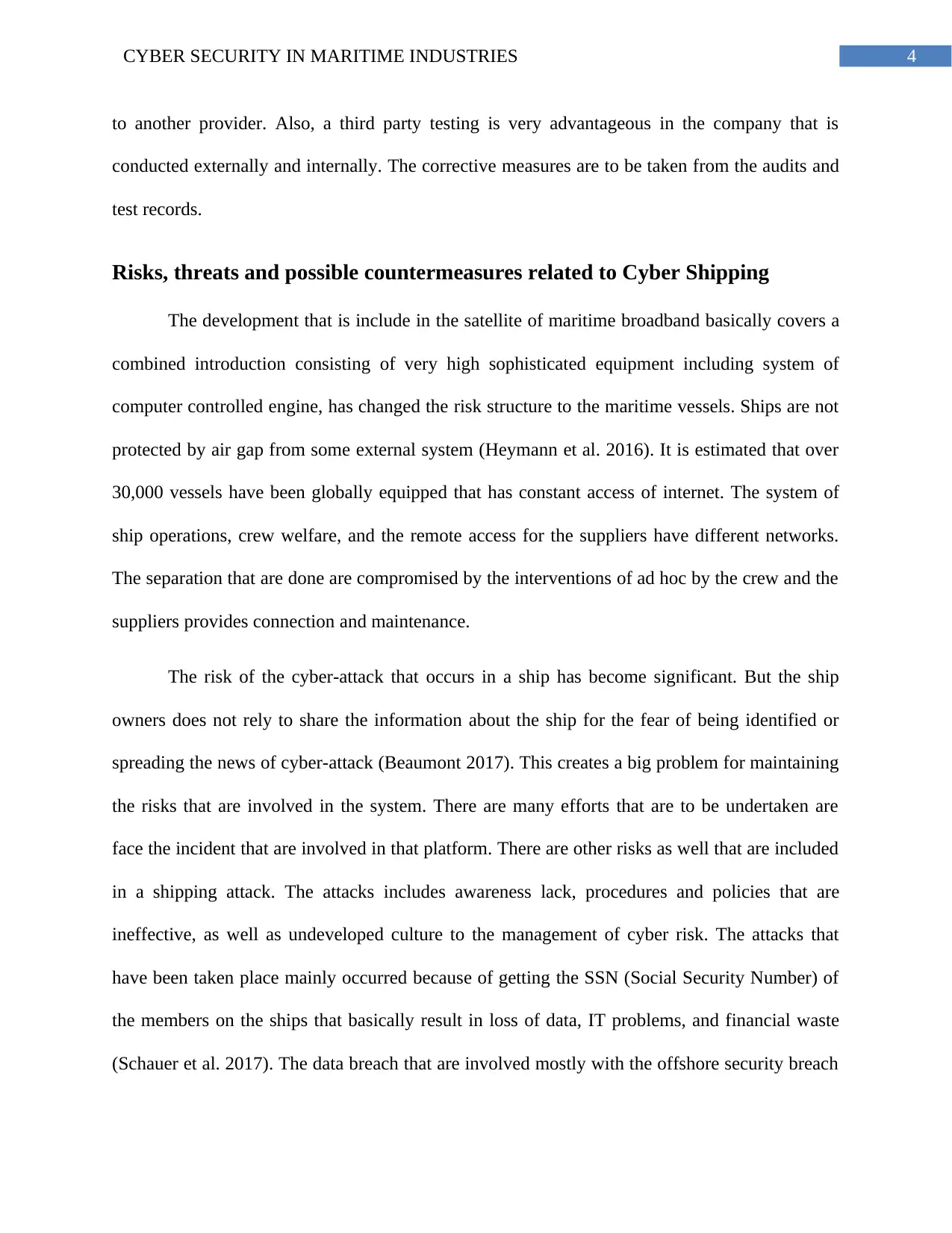
4CYBER SECURITY IN MARITIME INDUSTRIES
to another provider. Also, a third party testing is very advantageous in the company that is
conducted externally and internally. The corrective measures are to be taken from the audits and
test records.
Risks, threats and possible countermeasures related to Cyber Shipping
The development that is include in the satellite of maritime broadband basically covers a
combined introduction consisting of very high sophisticated equipment including system of
computer controlled engine, has changed the risk structure to the maritime vessels. Ships are not
protected by air gap from some external system (Heymann et al. 2016). It is estimated that over
30,000 vessels have been globally equipped that has constant access of internet. The system of
ship operations, crew welfare, and the remote access for the suppliers have different networks.
The separation that are done are compromised by the interventions of ad hoc by the crew and the
suppliers provides connection and maintenance.
The risk of the cyber-attack that occurs in a ship has become significant. But the ship
owners does not rely to share the information about the ship for the fear of being identified or
spreading the news of cyber-attack (Beaumont 2017). This creates a big problem for maintaining
the risks that are involved in the system. There are many efforts that are to be undertaken are
face the incident that are involved in that platform. There are other risks as well that are included
in a shipping attack. The attacks includes awareness lack, procedures and policies that are
ineffective, as well as undeveloped culture to the management of cyber risk. The attacks that
have been taken place mainly occurred because of getting the SSN (Social Security Number) of
the members on the ships that basically result in loss of data, IT problems, and financial waste
(Schauer et al. 2017). The data breach that are involved mostly with the offshore security breach
to another provider. Also, a third party testing is very advantageous in the company that is
conducted externally and internally. The corrective measures are to be taken from the audits and
test records.
Risks, threats and possible countermeasures related to Cyber Shipping
The development that is include in the satellite of maritime broadband basically covers a
combined introduction consisting of very high sophisticated equipment including system of
computer controlled engine, has changed the risk structure to the maritime vessels. Ships are not
protected by air gap from some external system (Heymann et al. 2016). It is estimated that over
30,000 vessels have been globally equipped that has constant access of internet. The system of
ship operations, crew welfare, and the remote access for the suppliers have different networks.
The separation that are done are compromised by the interventions of ad hoc by the crew and the
suppliers provides connection and maintenance.
The risk of the cyber-attack that occurs in a ship has become significant. But the ship
owners does not rely to share the information about the ship for the fear of being identified or
spreading the news of cyber-attack (Beaumont 2017). This creates a big problem for maintaining
the risks that are involved in the system. There are many efforts that are to be undertaken are
face the incident that are involved in that platform. There are other risks as well that are included
in a shipping attack. The attacks includes awareness lack, procedures and policies that are
ineffective, as well as undeveloped culture to the management of cyber risk. The attacks that
have been taken place mainly occurred because of getting the SSN (Social Security Number) of
the members on the ships that basically result in loss of data, IT problems, and financial waste
(Schauer et al. 2017). The data breach that are involved mostly with the offshore security breach
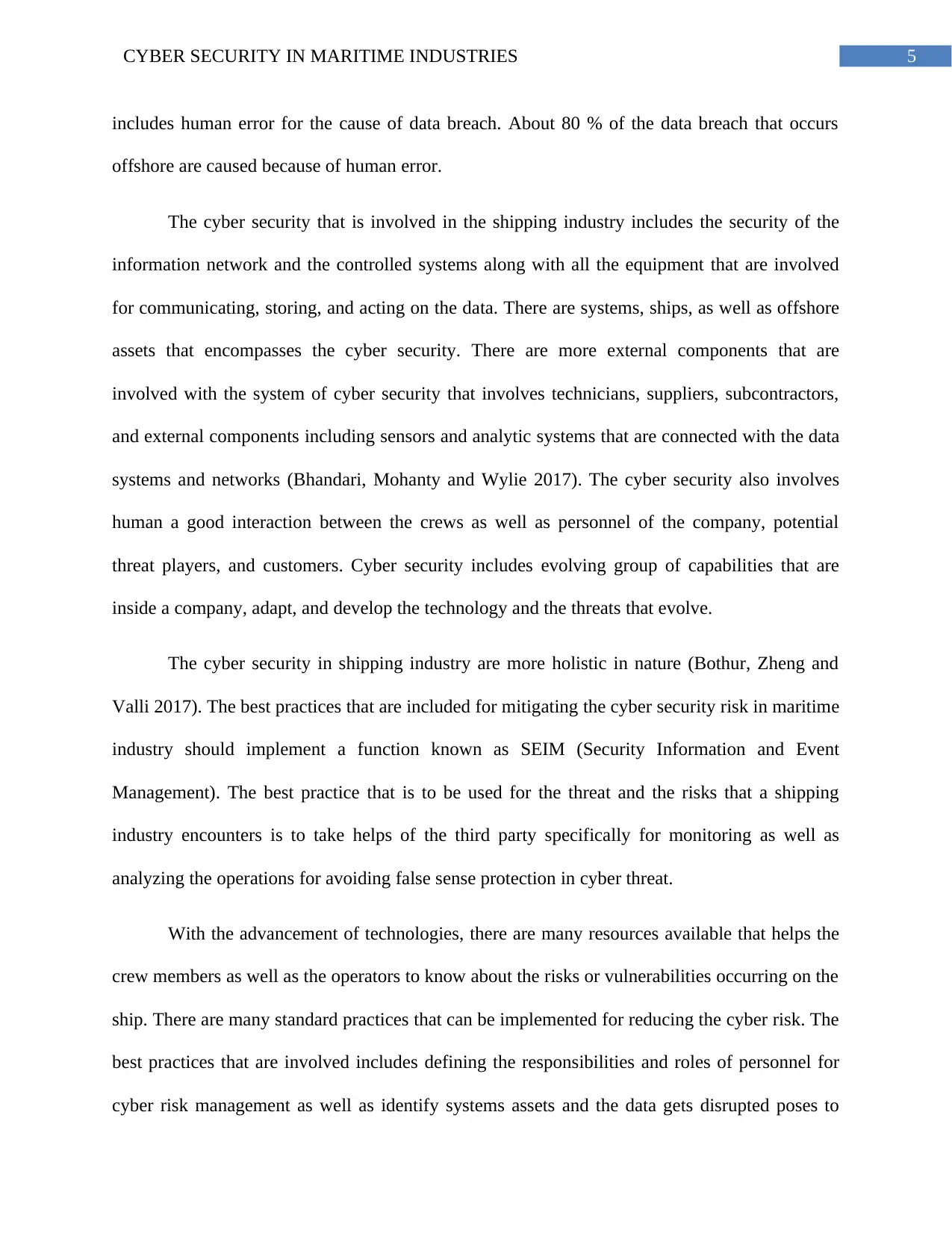
5CYBER SECURITY IN MARITIME INDUSTRIES
includes human error for the cause of data breach. About 80 % of the data breach that occurs
offshore are caused because of human error.
The cyber security that is involved in the shipping industry includes the security of the
information network and the controlled systems along with all the equipment that are involved
for communicating, storing, and acting on the data. There are systems, ships, as well as offshore
assets that encompasses the cyber security. There are more external components that are
involved with the system of cyber security that involves technicians, suppliers, subcontractors,
and external components including sensors and analytic systems that are connected with the data
systems and networks (Bhandari, Mohanty and Wylie 2017). The cyber security also involves
human a good interaction between the crews as well as personnel of the company, potential
threat players, and customers. Cyber security includes evolving group of capabilities that are
inside a company, adapt, and develop the technology and the threats that evolve.
The cyber security in shipping industry are more holistic in nature (Bothur, Zheng and
Valli 2017). The best practices that are included for mitigating the cyber security risk in maritime
industry should implement a function known as SEIM (Security Information and Event
Management). The best practice that is to be used for the threat and the risks that a shipping
industry encounters is to take helps of the third party specifically for monitoring as well as
analyzing the operations for avoiding false sense protection in cyber threat.
With the advancement of technologies, there are many resources available that helps the
crew members as well as the operators to know about the risks or vulnerabilities occurring on the
ship. There are many standard practices that can be implemented for reducing the cyber risk. The
best practices that are involved includes defining the responsibilities and roles of personnel for
cyber risk management as well as identify systems assets and the data gets disrupted poses to
includes human error for the cause of data breach. About 80 % of the data breach that occurs
offshore are caused because of human error.
The cyber security that is involved in the shipping industry includes the security of the
information network and the controlled systems along with all the equipment that are involved
for communicating, storing, and acting on the data. There are systems, ships, as well as offshore
assets that encompasses the cyber security. There are more external components that are
involved with the system of cyber security that involves technicians, suppliers, subcontractors,
and external components including sensors and analytic systems that are connected with the data
systems and networks (Bhandari, Mohanty and Wylie 2017). The cyber security also involves
human a good interaction between the crews as well as personnel of the company, potential
threat players, and customers. Cyber security includes evolving group of capabilities that are
inside a company, adapt, and develop the technology and the threats that evolve.
The cyber security in shipping industry are more holistic in nature (Bothur, Zheng and
Valli 2017). The best practices that are included for mitigating the cyber security risk in maritime
industry should implement a function known as SEIM (Security Information and Event
Management). The best practice that is to be used for the threat and the risks that a shipping
industry encounters is to take helps of the third party specifically for monitoring as well as
analyzing the operations for avoiding false sense protection in cyber threat.
With the advancement of technologies, there are many resources available that helps the
crew members as well as the operators to know about the risks or vulnerabilities occurring on the
ship. There are many standard practices that can be implemented for reducing the cyber risk. The
best practices that are involved includes defining the responsibilities and roles of personnel for
cyber risk management as well as identify systems assets and the data gets disrupted poses to
⊘ This is a preview!⊘
Do you want full access?
Subscribe today to unlock all pages.

Trusted by 1+ million students worldwide
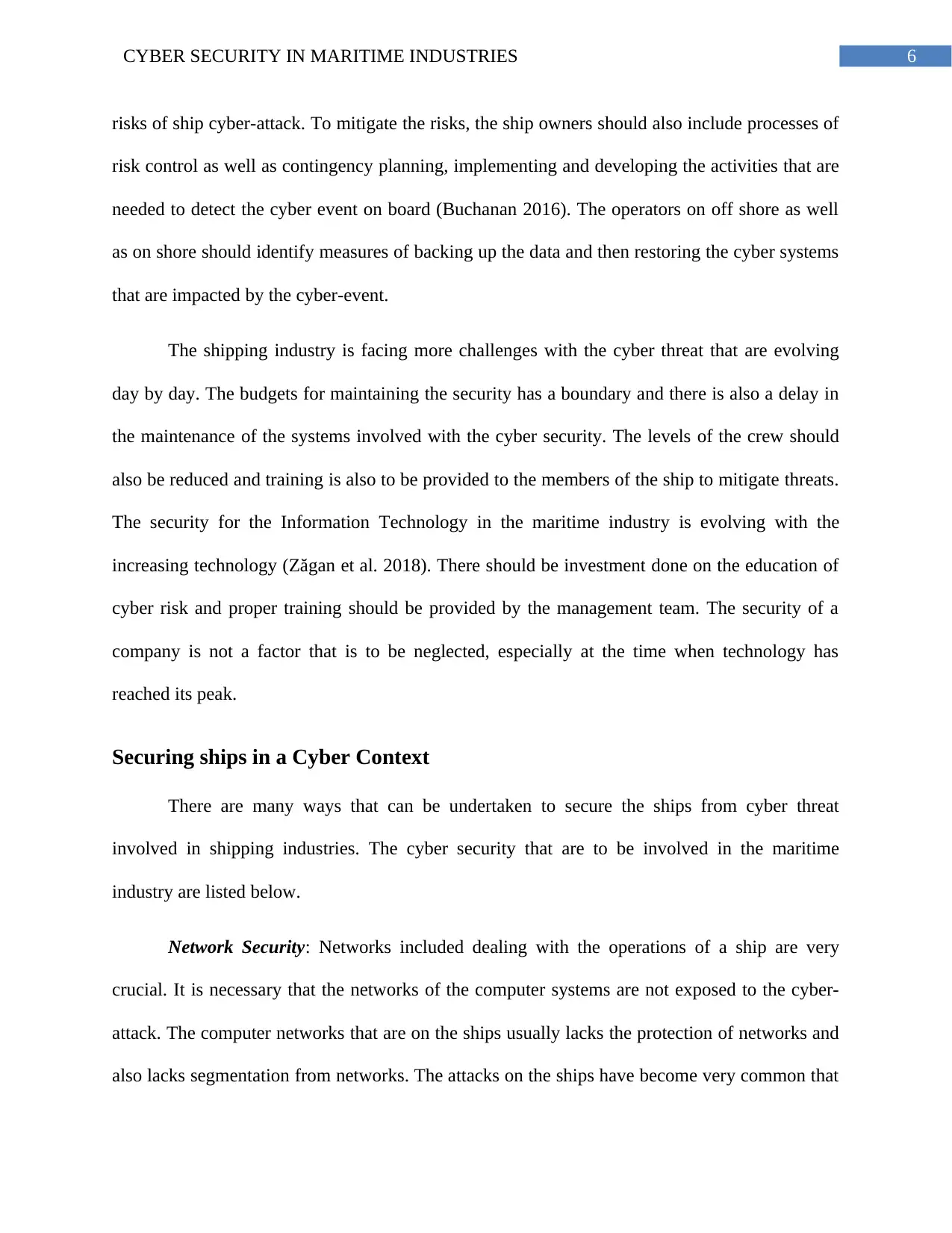
6CYBER SECURITY IN MARITIME INDUSTRIES
risks of ship cyber-attack. To mitigate the risks, the ship owners should also include processes of
risk control as well as contingency planning, implementing and developing the activities that are
needed to detect the cyber event on board (Buchanan 2016). The operators on off shore as well
as on shore should identify measures of backing up the data and then restoring the cyber systems
that are impacted by the cyber-event.
The shipping industry is facing more challenges with the cyber threat that are evolving
day by day. The budgets for maintaining the security has a boundary and there is also a delay in
the maintenance of the systems involved with the cyber security. The levels of the crew should
also be reduced and training is also to be provided to the members of the ship to mitigate threats.
The security for the Information Technology in the maritime industry is evolving with the
increasing technology (Zăgan et al. 2018). There should be investment done on the education of
cyber risk and proper training should be provided by the management team. The security of a
company is not a factor that is to be neglected, especially at the time when technology has
reached its peak.
Securing ships in a Cyber Context
There are many ways that can be undertaken to secure the ships from cyber threat
involved in shipping industries. The cyber security that are to be involved in the maritime
industry are listed below.
Network Security: Networks included dealing with the operations of a ship are very
crucial. It is necessary that the networks of the computer systems are not exposed to the cyber-
attack. The computer networks that are on the ships usually lacks the protection of networks and
also lacks segmentation from networks. The attacks on the ships have become very common that
risks of ship cyber-attack. To mitigate the risks, the ship owners should also include processes of
risk control as well as contingency planning, implementing and developing the activities that are
needed to detect the cyber event on board (Buchanan 2016). The operators on off shore as well
as on shore should identify measures of backing up the data and then restoring the cyber systems
that are impacted by the cyber-event.
The shipping industry is facing more challenges with the cyber threat that are evolving
day by day. The budgets for maintaining the security has a boundary and there is also a delay in
the maintenance of the systems involved with the cyber security. The levels of the crew should
also be reduced and training is also to be provided to the members of the ship to mitigate threats.
The security for the Information Technology in the maritime industry is evolving with the
increasing technology (Zăgan et al. 2018). There should be investment done on the education of
cyber risk and proper training should be provided by the management team. The security of a
company is not a factor that is to be neglected, especially at the time when technology has
reached its peak.
Securing ships in a Cyber Context
There are many ways that can be undertaken to secure the ships from cyber threat
involved in shipping industries. The cyber security that are to be involved in the maritime
industry are listed below.
Network Security: Networks included dealing with the operations of a ship are very
crucial. It is necessary that the networks of the computer systems are not exposed to the cyber-
attack. The computer networks that are on the ships usually lacks the protection of networks and
also lacks segmentation from networks. The attacks on the ships have become very common that
Paraphrase This Document
Need a fresh take? Get an instant paraphrase of this document with our AI Paraphraser
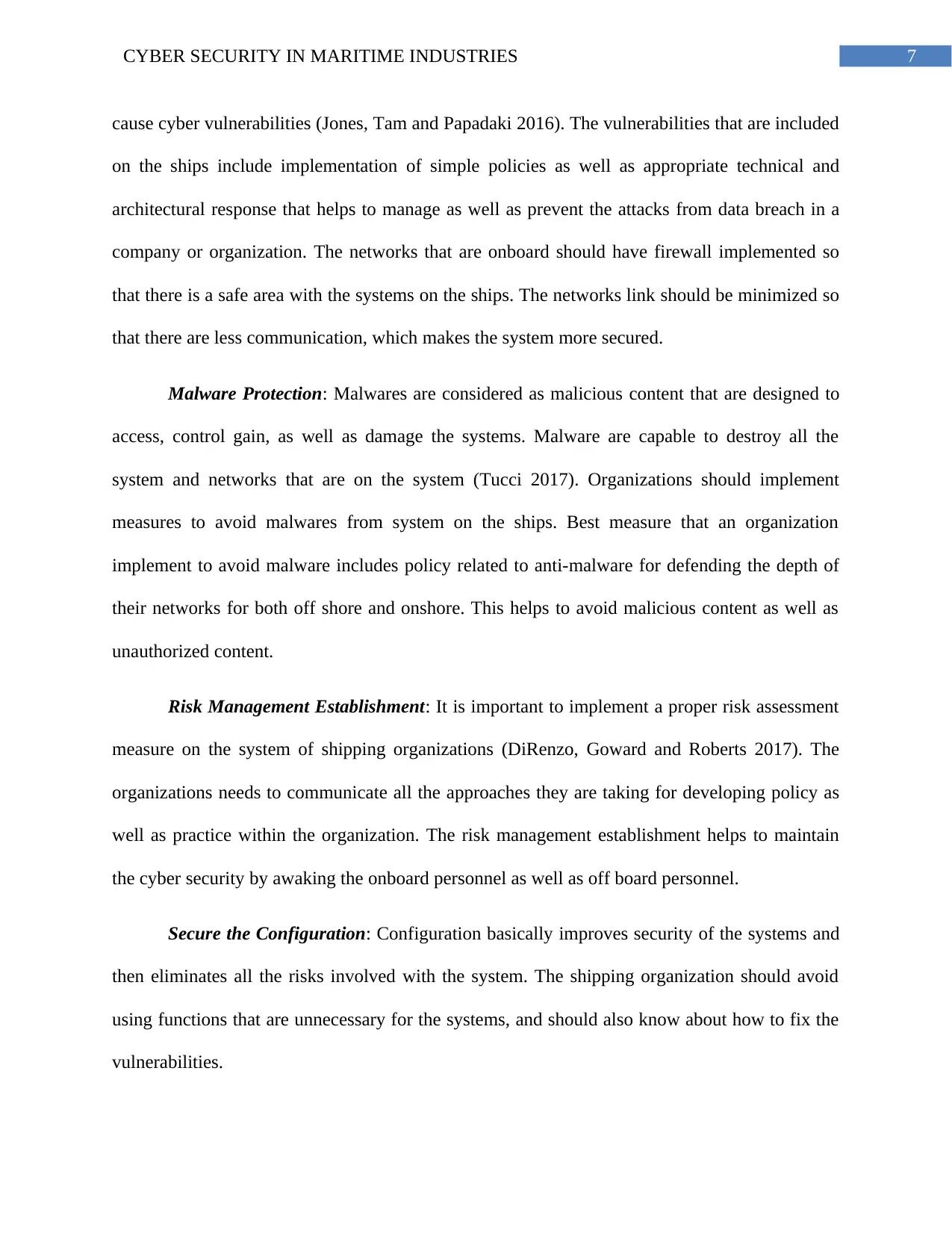
7CYBER SECURITY IN MARITIME INDUSTRIES
cause cyber vulnerabilities (Jones, Tam and Papadaki 2016). The vulnerabilities that are included
on the ships include implementation of simple policies as well as appropriate technical and
architectural response that helps to manage as well as prevent the attacks from data breach in a
company or organization. The networks that are onboard should have firewall implemented so
that there is a safe area with the systems on the ships. The networks link should be minimized so
that there are less communication, which makes the system more secured.
Malware Protection: Malwares are considered as malicious content that are designed to
access, control gain, as well as damage the systems. Malware are capable to destroy all the
system and networks that are on the system (Tucci 2017). Organizations should implement
measures to avoid malwares from system on the ships. Best measure that an organization
implement to avoid malware includes policy related to anti-malware for defending the depth of
their networks for both off shore and onshore. This helps to avoid malicious content as well as
unauthorized content.
Risk Management Establishment: It is important to implement a proper risk assessment
measure on the system of shipping organizations (DiRenzo, Goward and Roberts 2017). The
organizations needs to communicate all the approaches they are taking for developing policy as
well as practice within the organization. The risk management establishment helps to maintain
the cyber security by awaking the onboard personnel as well as off board personnel.
Secure the Configuration: Configuration basically improves security of the systems and
then eliminates all the risks involved with the system. The shipping organization should avoid
using functions that are unnecessary for the systems, and should also know about how to fix the
vulnerabilities.
cause cyber vulnerabilities (Jones, Tam and Papadaki 2016). The vulnerabilities that are included
on the ships include implementation of simple policies as well as appropriate technical and
architectural response that helps to manage as well as prevent the attacks from data breach in a
company or organization. The networks that are onboard should have firewall implemented so
that there is a safe area with the systems on the ships. The networks link should be minimized so
that there are less communication, which makes the system more secured.
Malware Protection: Malwares are considered as malicious content that are designed to
access, control gain, as well as damage the systems. Malware are capable to destroy all the
system and networks that are on the system (Tucci 2017). Organizations should implement
measures to avoid malwares from system on the ships. Best measure that an organization
implement to avoid malware includes policy related to anti-malware for defending the depth of
their networks for both off shore and onshore. This helps to avoid malicious content as well as
unauthorized content.
Risk Management Establishment: It is important to implement a proper risk assessment
measure on the system of shipping organizations (DiRenzo, Goward and Roberts 2017). The
organizations needs to communicate all the approaches they are taking for developing policy as
well as practice within the organization. The risk management establishment helps to maintain
the cyber security by awaking the onboard personnel as well as off board personnel.
Secure the Configuration: Configuration basically improves security of the systems and
then eliminates all the risks involved with the system. The shipping organization should avoid
using functions that are unnecessary for the systems, and should also know about how to fix the
vulnerabilities.
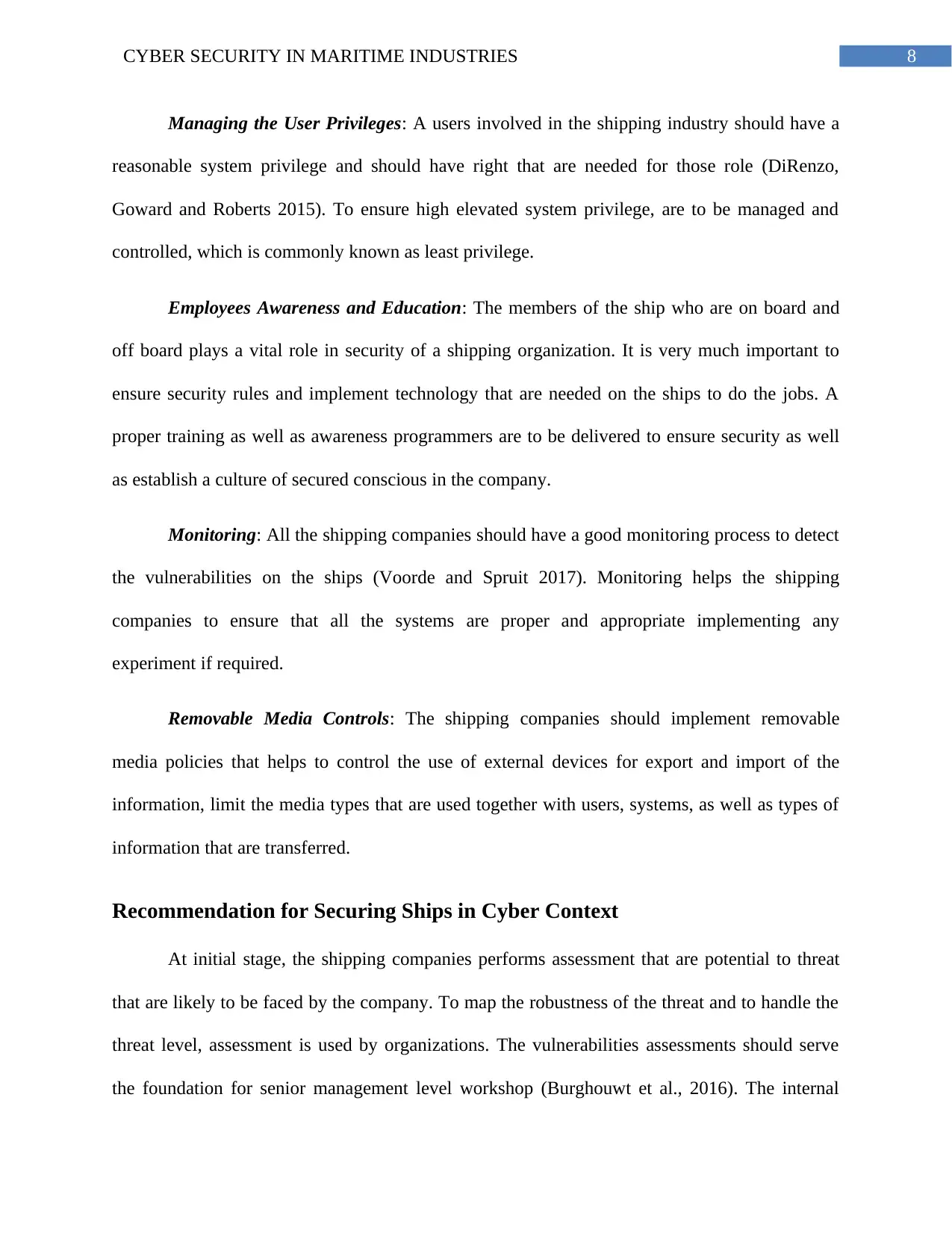
8CYBER SECURITY IN MARITIME INDUSTRIES
Managing the User Privileges: A users involved in the shipping industry should have a
reasonable system privilege and should have right that are needed for those role (DiRenzo,
Goward and Roberts 2015). To ensure high elevated system privilege, are to be managed and
controlled, which is commonly known as least privilege.
Employees Awareness and Education: The members of the ship who are on board and
off board plays a vital role in security of a shipping organization. It is very much important to
ensure security rules and implement technology that are needed on the ships to do the jobs. A
proper training as well as awareness programmers are to be delivered to ensure security as well
as establish a culture of secured conscious in the company.
Monitoring: All the shipping companies should have a good monitoring process to detect
the vulnerabilities on the ships (Voorde and Spruit 2017). Monitoring helps the shipping
companies to ensure that all the systems are proper and appropriate implementing any
experiment if required.
Removable Media Controls: The shipping companies should implement removable
media policies that helps to control the use of external devices for export and import of the
information, limit the media types that are used together with users, systems, as well as types of
information that are transferred.
Recommendation for Securing Ships in Cyber Context
At initial stage, the shipping companies performs assessment that are potential to threat
that are likely to be faced by the company. To map the robustness of the threat and to handle the
threat level, assessment is used by organizations. The vulnerabilities assessments should serve
the foundation for senior management level workshop (Burghouwt et al., 2016). The internal
Managing the User Privileges: A users involved in the shipping industry should have a
reasonable system privilege and should have right that are needed for those role (DiRenzo,
Goward and Roberts 2015). To ensure high elevated system privilege, are to be managed and
controlled, which is commonly known as least privilege.
Employees Awareness and Education: The members of the ship who are on board and
off board plays a vital role in security of a shipping organization. It is very much important to
ensure security rules and implement technology that are needed on the ships to do the jobs. A
proper training as well as awareness programmers are to be delivered to ensure security as well
as establish a culture of secured conscious in the company.
Monitoring: All the shipping companies should have a good monitoring process to detect
the vulnerabilities on the ships (Voorde and Spruit 2017). Monitoring helps the shipping
companies to ensure that all the systems are proper and appropriate implementing any
experiment if required.
Removable Media Controls: The shipping companies should implement removable
media policies that helps to control the use of external devices for export and import of the
information, limit the media types that are used together with users, systems, as well as types of
information that are transferred.
Recommendation for Securing Ships in Cyber Context
At initial stage, the shipping companies performs assessment that are potential to threat
that are likely to be faced by the company. To map the robustness of the threat and to handle the
threat level, assessment is used by organizations. The vulnerabilities assessments should serve
the foundation for senior management level workshop (Burghouwt et al., 2016). The internal
⊘ This is a preview!⊘
Do you want full access?
Subscribe today to unlock all pages.

Trusted by 1+ million students worldwide
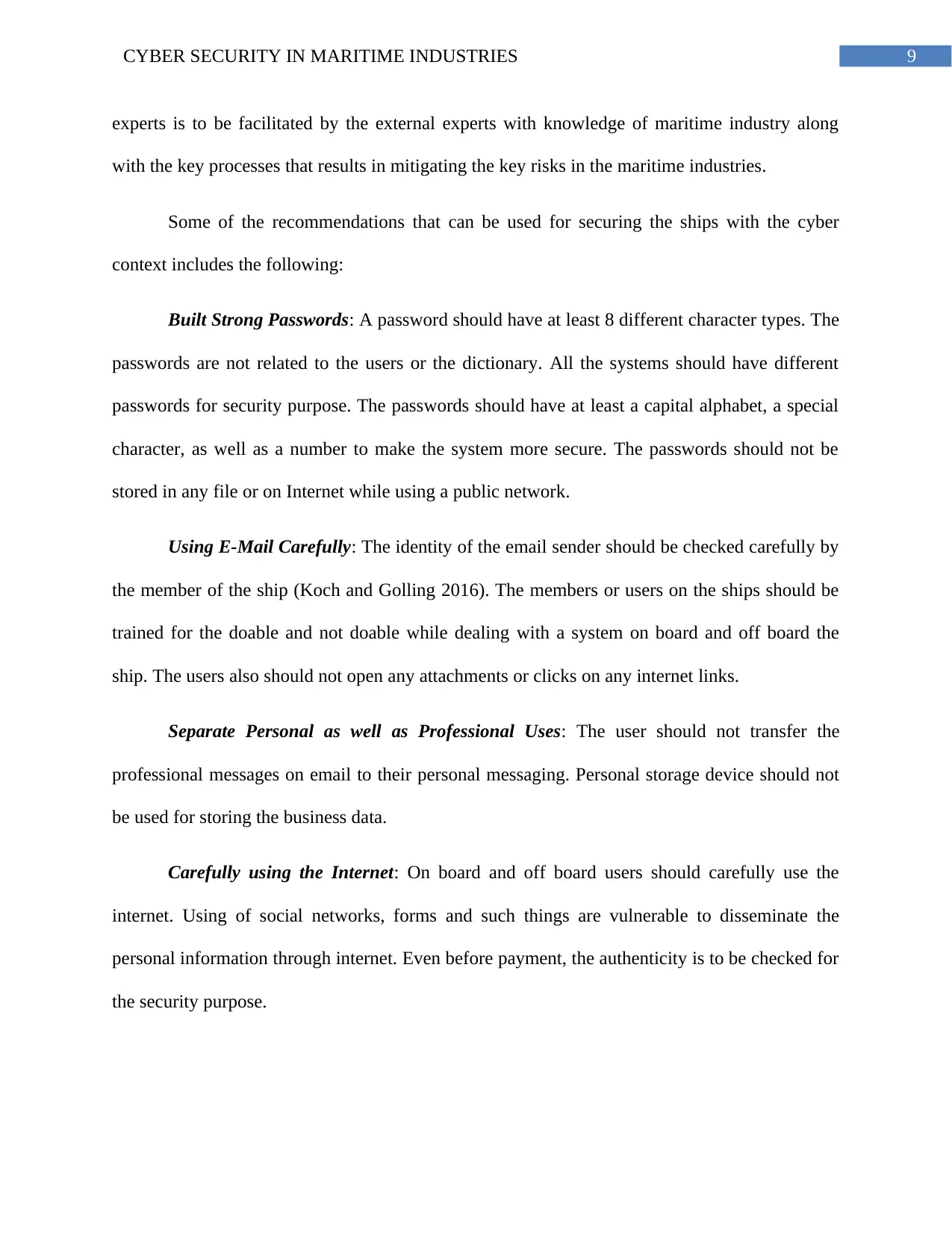
9CYBER SECURITY IN MARITIME INDUSTRIES
experts is to be facilitated by the external experts with knowledge of maritime industry along
with the key processes that results in mitigating the key risks in the maritime industries.
Some of the recommendations that can be used for securing the ships with the cyber
context includes the following:
Built Strong Passwords: A password should have at least 8 different character types. The
passwords are not related to the users or the dictionary. All the systems should have different
passwords for security purpose. The passwords should have at least a capital alphabet, a special
character, as well as a number to make the system more secure. The passwords should not be
stored in any file or on Internet while using a public network.
Using E-Mail Carefully: The identity of the email sender should be checked carefully by
the member of the ship (Koch and Golling 2016). The members or users on the ships should be
trained for the doable and not doable while dealing with a system on board and off board the
ship. The users also should not open any attachments or clicks on any internet links.
Separate Personal as well as Professional Uses: The user should not transfer the
professional messages on email to their personal messaging. Personal storage device should not
be used for storing the business data.
Carefully using the Internet: On board and off board users should carefully use the
internet. Using of social networks, forms and such things are vulnerable to disseminate the
personal information through internet. Even before payment, the authenticity is to be checked for
the security purpose.
experts is to be facilitated by the external experts with knowledge of maritime industry along
with the key processes that results in mitigating the key risks in the maritime industries.
Some of the recommendations that can be used for securing the ships with the cyber
context includes the following:
Built Strong Passwords: A password should have at least 8 different character types. The
passwords are not related to the users or the dictionary. All the systems should have different
passwords for security purpose. The passwords should have at least a capital alphabet, a special
character, as well as a number to make the system more secure. The passwords should not be
stored in any file or on Internet while using a public network.
Using E-Mail Carefully: The identity of the email sender should be checked carefully by
the member of the ship (Koch and Golling 2016). The members or users on the ships should be
trained for the doable and not doable while dealing with a system on board and off board the
ship. The users also should not open any attachments or clicks on any internet links.
Separate Personal as well as Professional Uses: The user should not transfer the
professional messages on email to their personal messaging. Personal storage device should not
be used for storing the business data.
Carefully using the Internet: On board and off board users should carefully use the
internet. Using of social networks, forms and such things are vulnerable to disseminate the
personal information through internet. Even before payment, the authenticity is to be checked for
the security purpose.
Paraphrase This Document
Need a fresh take? Get an instant paraphrase of this document with our AI Paraphraser
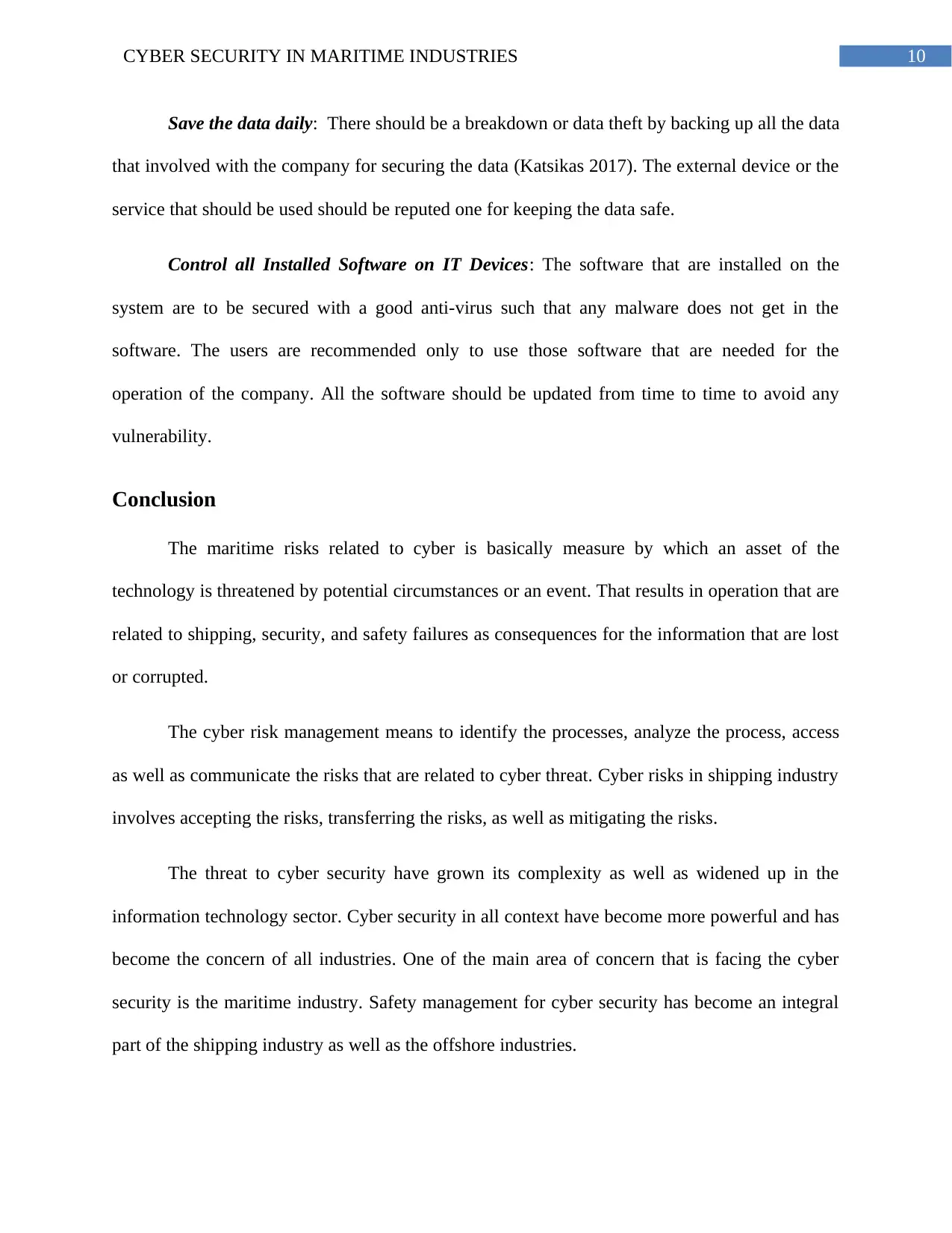
10CYBER SECURITY IN MARITIME INDUSTRIES
Save the data daily: There should be a breakdown or data theft by backing up all the data
that involved with the company for securing the data (Katsikas 2017). The external device or the
service that should be used should be reputed one for keeping the data safe.
Control all Installed Software on IT Devices: The software that are installed on the
system are to be secured with a good anti-virus such that any malware does not get in the
software. The users are recommended only to use those software that are needed for the
operation of the company. All the software should be updated from time to time to avoid any
vulnerability.
Conclusion
The maritime risks related to cyber is basically measure by which an asset of the
technology is threatened by potential circumstances or an event. That results in operation that are
related to shipping, security, and safety failures as consequences for the information that are lost
or corrupted.
The cyber risk management means to identify the processes, analyze the process, access
as well as communicate the risks that are related to cyber threat. Cyber risks in shipping industry
involves accepting the risks, transferring the risks, as well as mitigating the risks.
The threat to cyber security have grown its complexity as well as widened up in the
information technology sector. Cyber security in all context have become more powerful and has
become the concern of all industries. One of the main area of concern that is facing the cyber
security is the maritime industry. Safety management for cyber security has become an integral
part of the shipping industry as well as the offshore industries.
Save the data daily: There should be a breakdown or data theft by backing up all the data
that involved with the company for securing the data (Katsikas 2017). The external device or the
service that should be used should be reputed one for keeping the data safe.
Control all Installed Software on IT Devices: The software that are installed on the
system are to be secured with a good anti-virus such that any malware does not get in the
software. The users are recommended only to use those software that are needed for the
operation of the company. All the software should be updated from time to time to avoid any
vulnerability.
Conclusion
The maritime risks related to cyber is basically measure by which an asset of the
technology is threatened by potential circumstances or an event. That results in operation that are
related to shipping, security, and safety failures as consequences for the information that are lost
or corrupted.
The cyber risk management means to identify the processes, analyze the process, access
as well as communicate the risks that are related to cyber threat. Cyber risks in shipping industry
involves accepting the risks, transferring the risks, as well as mitigating the risks.
The threat to cyber security have grown its complexity as well as widened up in the
information technology sector. Cyber security in all context have become more powerful and has
become the concern of all industries. One of the main area of concern that is facing the cyber
security is the maritime industry. Safety management for cyber security has become an integral
part of the shipping industry as well as the offshore industries.
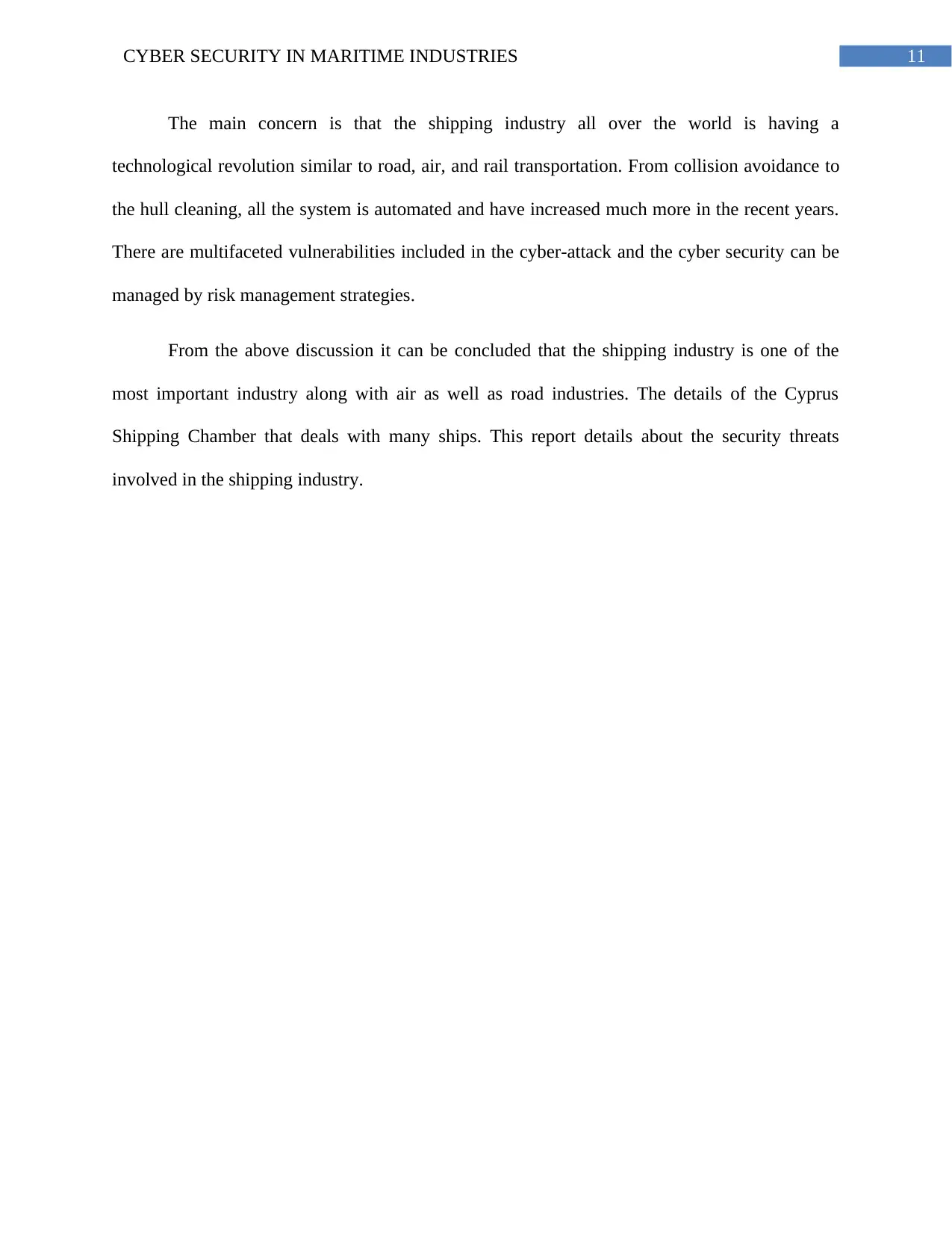
11CYBER SECURITY IN MARITIME INDUSTRIES
The main concern is that the shipping industry all over the world is having a
technological revolution similar to road, air, and rail transportation. From collision avoidance to
the hull cleaning, all the system is automated and have increased much more in the recent years.
There are multifaceted vulnerabilities included in the cyber-attack and the cyber security can be
managed by risk management strategies.
From the above discussion it can be concluded that the shipping industry is one of the
most important industry along with air as well as road industries. The details of the Cyprus
Shipping Chamber that deals with many ships. This report details about the security threats
involved in the shipping industry.
The main concern is that the shipping industry all over the world is having a
technological revolution similar to road, air, and rail transportation. From collision avoidance to
the hull cleaning, all the system is automated and have increased much more in the recent years.
There are multifaceted vulnerabilities included in the cyber-attack and the cyber security can be
managed by risk management strategies.
From the above discussion it can be concluded that the shipping industry is one of the
most important industry along with air as well as road industries. The details of the Cyprus
Shipping Chamber that deals with many ships. This report details about the security threats
involved in the shipping industry.
⊘ This is a preview!⊘
Do you want full access?
Subscribe today to unlock all pages.

Trusted by 1+ million students worldwide
1 out of 15
Related Documents
Your All-in-One AI-Powered Toolkit for Academic Success.
+13062052269
info@desklib.com
Available 24*7 on WhatsApp / Email
![[object Object]](/_next/static/media/star-bottom.7253800d.svg)
Unlock your academic potential
Copyright © 2020–2025 A2Z Services. All Rights Reserved. Developed and managed by ZUCOL.





